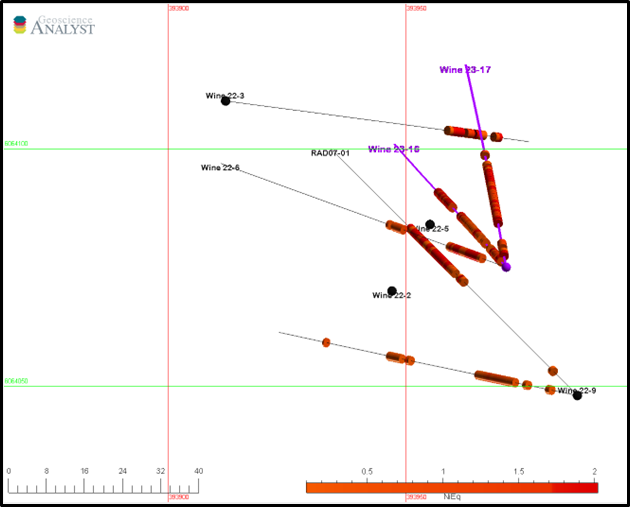Toronto, Ontario – May 24, 2023 – NiCAN Limited (“NiCAN” or the “Company”) (TSX-V:NICN) is pleased to announce that its 2023 winter drilling program on the Wine Property located in the Snow Lake area, Manitoba, Canada (Figure 2) has expanded several mineralized zones at the Wine Occurrence.
Highlights:
- Diamond drill hole Wine 23-16 intersected four zones of mineralization including 12.6 meters at 1.52% Ni and 2.01% Cu (1.93% NiEq), from 48.3 to 60.9 meters (Table 1).
- Diamond drill hole Wine 23-17 intersected three zones of mineralization including 23.5 meters at 1.59% Ni and 1.76% Cu, (1.91% NiEq), from 18.6 to 42.1 meters (Table 1, Figure 1).
Note: Nickel equivalent grades include nickel and copper values only and assume recoveries of 85% for nickel and 85% for copper based on comparable deposits. Nickel price: US$10.00/lb; copper price US$3.75/lb.
Table 1: Composite Assays Wine-23-16 and 23-17
| Hole # | From | To | m | Co% | Cu% | Ni% | PGM g/t | NiEq% |
| Wine 23-16 | 4.2 | 11.9 | 7.7 | 0.042 | 1.69 | 1.12 | 0.367 | 1.49 |
| Wine 23-16 | 23.7 | 28.0 | 4.3 | 0.042 | 1.96 | 0.98 | 0.659 | 1.46 |
| Wine 23-16 | 33.8 | 41.3 | 7.5 | 0.048 | 1.02 | 1.13 | 0.444 | 1.29 |
| Wine 23-16 | 48.3 | 60.9 | 12.6 | 0.063 | 2.01 | 1.52 | 0.649 | 1.93 |
| Wine 23-17 | 4.6 | 10.4 | 5.8 | 0.032 | 0.99 | 0.81 | 0.188 | 1.00 |
| Wine 23-17 | 18.6 | 42.1 | 23.5 | 0.067 | 1.76 | 1.59 | 0.514 | 1.91 |
| Wine 23-17 | 47.7 | 48.6 | 0.9 | 0.038 | 0.38 | 0.80 | 0.311 | 0.89 |
Brad Humphrey, President, and CEO of NiCAN, commented, “We are pleased with the results from the additional drilling at the Wine Occurrence, expanding the mineralization to the north. Our Phase II drill program at the Wine project had two objectives; we achieved the first, expanding, and increasing our understanding of, the known zones to the north of the Wine Occurrence. The second objective was to test several geophysical anomalies within the Wine Gabbro for anomalous nickel and copper values with a similar signature to that at the Wine Occurrence. We expect to report on the Wine Gabbro drilling in the coming weeks. The next step for the Wine project is to complete downhole and surface geophysics as well as geochemical surveys to assist in identifying targets for a follow-up drill program.”
Phase II Drill Program – Wine Occurrence
Diamond drill holes Wine 23-16 and Wine 23-17, drilled from an existing drill pad, tested an area to the north of diamond drill hole Wine 22-5, which intersected significant nickel-copper mineralization.
We interpret diamond drill hole Wine 23-16 to have intersected an upper, sub-cropping zone, which assayed 1.69% Cu and 1.12% Ni (1.49% NiEq) over 7.7 meters followed by two middle zones that returned 1.96% Cu and 0.98% Ni (1.46% NiEq) over 4.3 meters as well as 1.02% Cu and 1.13% Ni (1.29% NiEq) over 7.5 meters. The main zone returned 12.6 meters at 2.01% Cu and 1.52% Ni (1.93% NiEq). True widths are interpreted to be approximately 80% of intersected widths.
We believe diamond drill hole Wine 23-17 intersected the sub-cropping upper zone returning 0.99% Cu and 0.81% Ni (1.00% NiEq) over 5.8 meters. This was followed by a middle zone that assayed 1.76% Cu and 1.59% Ni (1.91% NiEq) over 23.5 meters. The hole drilled over the top of the main zone intersecting 0.9 meters at 0.43% Cu and 0.88% Ni (0.89% NiEq). It is interpreted that the two narrower mineralized zones encountered in holes Wine 22-5 and Wine 23-16 have merged into a broader zone to the north in hole Wine 22-17.
The mineralization remains open to the north.
Figure 1: Diamond drill hole Wine 23-17 from approximately 25.0 meters to 42.1 meters - Middle Zone mineralization
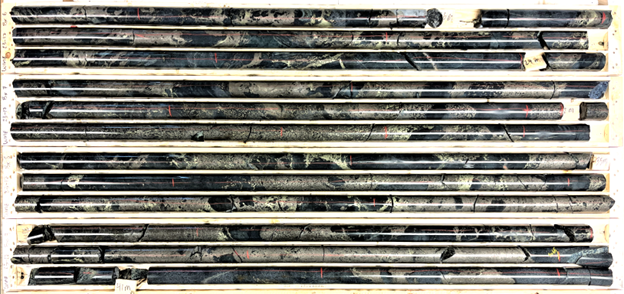

Phase II Exploration Program – Wine Property
The Phase II exploration program at the Wine project included approximately 2,800 meters of diamond drilling and was designed to drill test the Wine Occurrence to the north and drill test a number of additional greenfield geophysical targets throughout the Wine Gabbro. Results-dependent, many of the targets will subsequently be followed up with downhole and ground geophysics as well as geochemical surveys to further define targets for a Phase III exploration program which is expected to commence later this summer.
Over the broader Wine Gabbro area, multiple conductive targets identified by the Versatile Time Domain Electromagnetic (“VTEM”) airborne geophysical survey completed in 2022 (see press release dated November 14, 2022) were tested. The VTEM survey was designed to define the location and depth of conductive sources that have a similar signature to the high grade nickel hosted mineralization intersected at the Wine Occurrence.
The Phase II Wine drill program followed up on the significant results returned from the Phase I drill program completed in 2022, including:
- Diamond drill hole Wine 22-5 intersected 27.3 meters at 2.01% Ni and 1.81% Cu (2.28% NiEq);
- Diamond drill hole Wine 22-6 intersected 9.8 meters at 1.23% Ni and 2.09% Cu (1.71% NiEq); and
- Diamond drill hole Wine 22-3 intersected 8.6 meters at 1.89% Ni and 1.01% Cu (1.92% NiEq).
The additional downhole and surface Time Domain Electromagnetic (“TDEM”) surveys have been designed. The surveys are scheduled to be completed once permits have been approved.
Analogies to Historical Lynn Lake Nickel Deposits
NiCAN believes that the nickel mineralization hosted by the Wine Gabbro may have analogies to the nickel-copper deposits in the Lynn Lake area, which is to the north of the Wine property. At Lynn Lake, approximately 22.2 million tonnes averaging 1.0% nickel and 0.5% copper were historically mined at the Farley Mine. The Farley Mine consisted of multiple lenses of mineralization contained within a 4.2 km2 gabbro body. The Wine Gabbro contains numerous similarities and has seen very little exploration for nickel-copper deposits.
QAQC
All core samples are sent to the Saskatchewan Research Council (“SRC”) in Saskatoon (an accredited laboratory) by secure transport for base and precious metal assay. Base metals were assayed by their ICP3 package, which includes a total of 35 analytes by ICP-OES (Inductively Coupled Plasma – Optical Emission Spectroscopy). Partial digestions were performed on a 0.5 gram aliquot of sample pulp which was digested in a mixture of HCl:HNO3, in a hot water bath and then diluted to 15 ml using deionized water. Over-limits for copper, nickel and cobalt had an aliquot of 1.0 gram sample pulp digested in a concentration of HCl:HNO3. The digested volume was then made up with deionized water for analysis by ICP-OES. Fire Assay Techniques involved a 30 gram aliquot of sample pulp which was mixed with a standard fire assay flux in a clay crucible and a silver inquart added prior to fusion. After the mixture was fused, the melt was poured into a form which was cooled. The lead bead was then recovered and cupelled until only the precious metal bead remained. The bead was then parted in dilute HNO3. The precious metals were then dissolved in aqua regia and then diluted for analysis by ICP-OES
Laboratory Quality Control protocols were applied to the assay sample package by SRC. NiCAN submitted a regular schedule of standards, blanks and duplicates into the sample stream for Quality Control measures. Drill core samples are split in half using a diamond saw with half saved for reference and the other half shipped for assay. In the case of duplicate samples the half core is quarter split with the two quarter splits sent for separate assay.
The nickel equivalent grade calculation incorporates:
- nickel and copper values only,
- assume recoveries of 85% for nickel and 85% for copper based on comparable deposits,
- nickel price: US$10.00/lb; copper price US$3.75/lb.
Qualified Person
Mr. Bill Nielsen, P.Geo, a consultant to NiCAN, who is a qualified person under National Instrument 43-101 – Standards of Disclosure of Mineral Projects (“NI 43-101”) has reviewed and approved the scientific and technical information in this news release.
About NiCAN
NiCAN Limited is a mineral exploration company, trading under the symbol “NICN” on the TSX-V. The Company is actively exploring two nickel projects, both located in well-established mining jurisdictions in Manitoba, Canada.
Contact Information:
Brad Humphrey Sandy Noyes
President and CEO Investor Relations & Communications
416.565.4007 snoyes@NiCANLtd.com
info@NiCANLtd.com
Cautionary Note Regarding Forward-Looking Statements
The information contained herein contains certain “forward-looking information” under applicable securities laws concerning the proposed financing, business, operations and financial performance and condition of NiCAN Limited. Forward-looking information includes, but is not limited to, the size and timing of the drill program, results of the drill program, interpretations of the various surveys, NiCAN’s ability to identify mineralization similar to that found in prior drill holes, the benefits and the potential of the properties of the Company; future commodity prices (including in relation to NiEq calculations); drilling and other exploration potential; costs; and permitting. Forward-looking information may be characterized by words such as “plan,” “expect,” “project,” “intend,” “believe,” “anticipate”, “estimate” and other similar words, or statements that certain events or conditions “may” or “will” occur. Forward-looking information is based on the opinions and estimates of management at the date the statements are made and are based on a number of assumptions and subject to a variety of risks and uncertainties and other factors that could cause actual events or results to differ materially from those projected in the forward-looking information. Many of these assumptions are based on factors and events that are not within the control of the Company and there is no assurance they will prove to be correct. Factors that could cause actual results to vary materially from results anticipated by such forward-looking information includes changes in market conditions, fluctuating metal prices and currency exchange rates, the possibility of project cost overruns or unanticipated costs and expenses and permitting disputes and/or delays. Although the Company has attempted to identify important factors that could cause actual actions, events or results to differ materially from those described in forward-looking information, there may be other factors that cause actions, events or results not to be anticipated, estimated or intended. There can be no assurance that forward-looking information will prove to be accurate, as actual results and future events could differ materially from those anticipated in such statements. The Company undertakes no obligation to update forward-looking information if circumstances or management’s estimates or opinions should change except as required by applicable securities laws. The reader is cautioned not to place undue reliance on forward-looking information.
Neither TSX-V nor its Regulation Services Provider (as that term is defined in policies of the TSX-V) accepts responsibility for the adequacy or accuracy of this release.
Figure 2: Wine Project Location, Manitoba, Canada
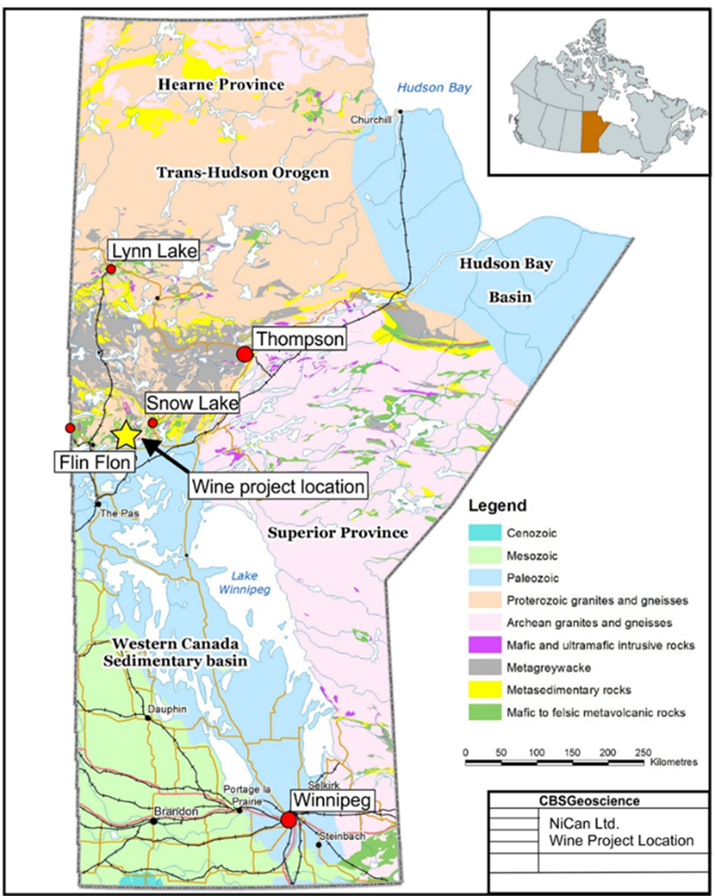
Figure 3: Historical and 2022 Drill Hole Locations – Diamond Drill holes Wine 23-16 and Wine 23-17, were drilled to the north from Diamond Drill pad Wine 22-06
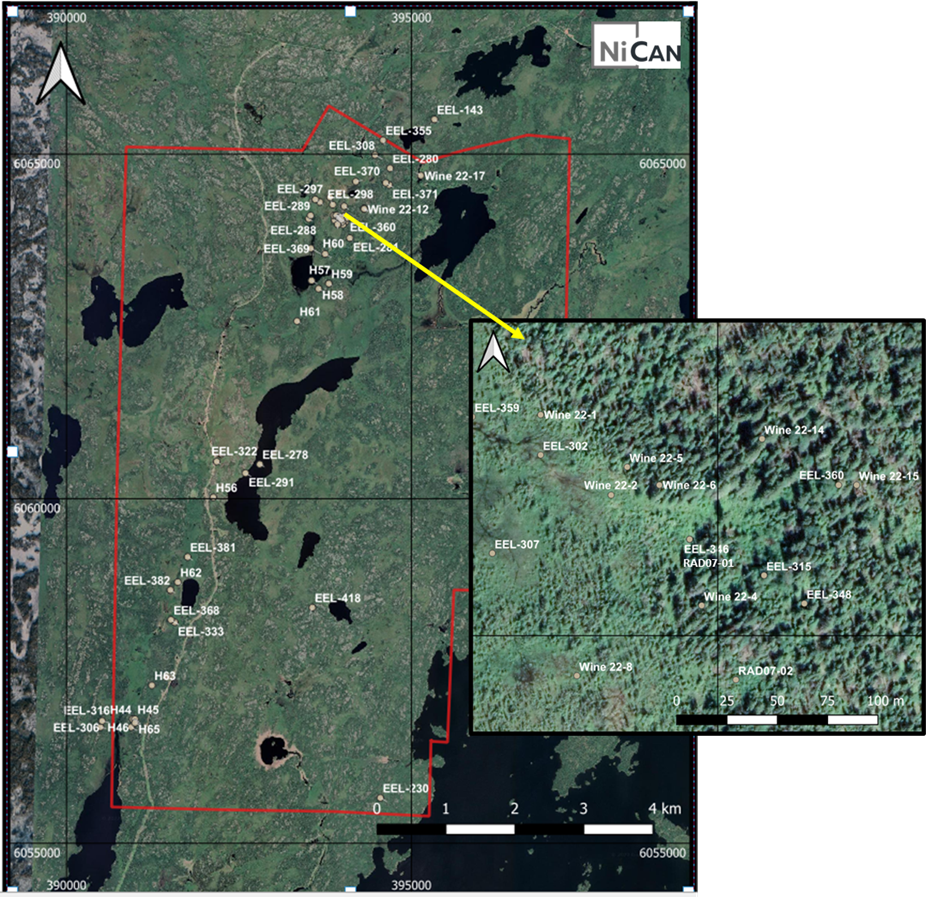
Figure 4: Interpreted Mineralized Zones with NiEq % Assays - Selected Drill Holes
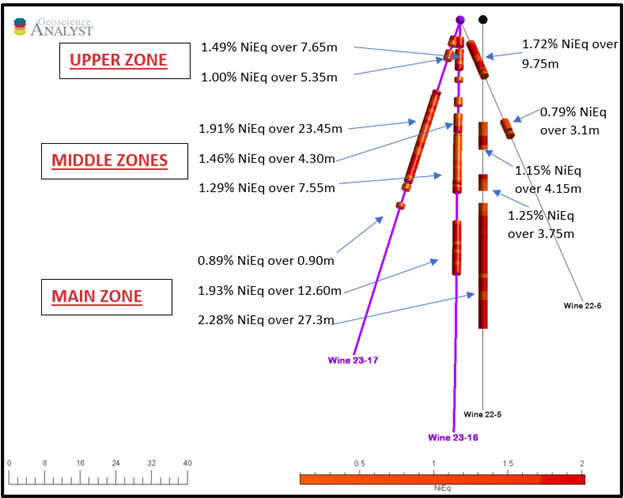
Note: Nickel equivalent grades include nickel and copper values only and assume recoveries of 85% for nickel and 85% for copper based on comparable deposits. Nickel price: US$10.00/lb; copper price US$3.75/lb.
Figure 5: Plan View of Drilling Wine Occurrence – Selected Holes
